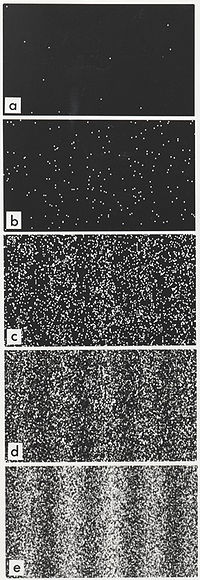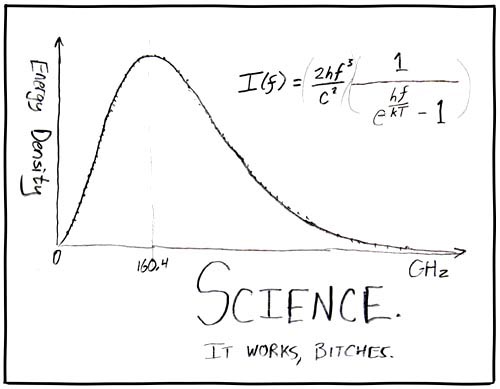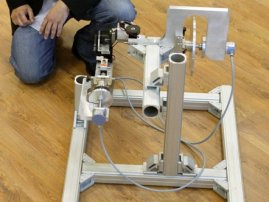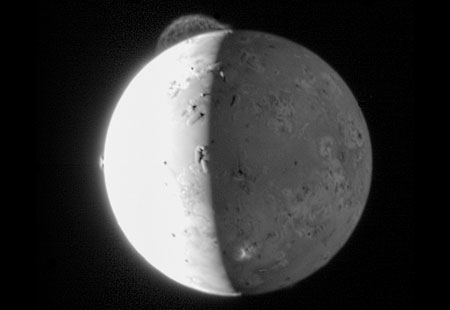 One physics experiment that is fascinating to contemplate is the double-slit experiment. You shine a light through a slit in a wall onto a light-sensitive screen behind it, and you get an exposure of light in the form of a single vertical line behind the slit. But if you open two slits in the wall and shine a light through, you don’t get two vertical lines of exposure–you get several: an interference pattern. The idea here is that light coming from each slit interferes with light coming from the other slit–like waves coming from two stones dropped into water–producing the multiple lines on the screen.
One physics experiment that is fascinating to contemplate is the double-slit experiment. You shine a light through a slit in a wall onto a light-sensitive screen behind it, and you get an exposure of light in the form of a single vertical line behind the slit. But if you open two slits in the wall and shine a light through, you don’t get two vertical lines of exposure–you get several: an interference pattern. The idea here is that light coming from each slit interferes with light coming from the other slit–like waves coming from two stones dropped into water–producing the multiple lines on the screen.
Normally, all this would prove is that light has wave-like properties, the waves from each slit interfering with each other. Now, if you perform the experiment again, except this time you only allow one “particle” of light through at a time, then you get the same result: an interference pattern. If only one “particle” of light is in motion at a time, going through only one slit, then what interferes with it? A wave makes sense–but we usually think of waves as bing made up of numerous parts. If there is only one “bit” or “piece” of light, how can it go through two slits at the same time, and then interfere with itself?
A wave makes sense–but we usually think of waves as bing made up of numerous parts. If there is only one “bit” or “piece” of light, how can it go through two slits at the same time, and then interfere with itself?
The popular solution to this problem is to assume that the particle did travel through both slits–in fact, the assumption is that the particle traveled every possible path from the light source to the screen. In essence, a vast horde of possible-particles each take slightly different paths, forming a virtual wave–and a wave can go through both slits, forming two wave-like patterns emerging from the other side of the slits, each one interfering with the other, creating the interference pattern. When the particle-wave hits the screen, the paths all “average out,” collapsing the vast number of possible-particles-wave into a single real one that represents the most likely path taken. Because interference was involved on the way to the screen, we get the interference pattern–despite there being only a single particle.
Some take this further, and suggest that instead of all those possible-particles existing in this universe alone, they represent a manifestation of the many-worlds hypothesis, where the light particles from many other universes much like our own interfere with the particle in our universe. In other words, the particle never becomes a wave, it simply interacts with particles from other universes which together resemble the effects of a wave.
But that’s not the end of the weirdness. Place sensors at the slits so we can sense which slit the particle is going through on its way to the screen, and something interesting happens: the interference pattern disappears, and we get two vertical lines.
This is due to what is called the “Copenhagen interpretation” of quantum theory. As stated above, all matter exists as that many-possible state, a “cloud” of possibilities, until it is observed. For example, if you flip a coin and it falls where you cannot see it, it is in a state of flux–it is both heads and tails, and exists in every possible location it could have possibly landed–and it stays that way until you shine a light on it and see it. Once you do that, the cloud of possible outcomes “collapses” into a single outcome, which is then “real.”
So, in the situation described above where the sensors are placed at the slits to see which one the particle passes through, we are observing the particle before it passes through the slits, therefore collapsing the possibilities and making it into a single “real” particle able only to pass through one slit–thus the interference pattern disappears.
In short, by observing the event, we change its outcome. That’s something which we hear about, but it sounds like some abstraction that doesn’t really affect actual events. However, the result of placing the sensor at the slits takes it from the theoretical to the real. It’s not just a thought experiment any more–it actually happens, and we can see it. It’s real.
Upon hearing about this, I had a question: what is causing the results to change? Is it something from the sensors at the slits which changes the nature of the particle? Or is it the fact that a conscious observer sees the data coming from the sensors? This is a key question: if consciousness is necessary, then this implies that consciousness is somehow tied into the laws of physics, so that a human observing something makes it “real” instead of simply possible.
So I thought of a way to test this: put the sensors at the slits, have them record the data–but then, before you see what pattern emerged on the light-sensitive screen, erase the slit-sensor data so no human ever sees it. If it is the sensors which are making the difference, then the waveform should collapse and the interference pattern disappears, no matter what the humans decide to observe.
For a long time, I thought no one actually did this experiment, until I found a lecture on YouTube where a physicist lays out exactly that test (see here and here). It’s called the “Delayed Choice” experiment.
The result: if the sensors are used, and the data is recorded–but then is erased before the screen’s pattern is looked at–the interference pattern reappears, as if the slit sensors had no effect. If the sensor data is not erased and is looked at before looking at the test’s results, then the interference pattern disappears. Meaning that it was the human viewing of the data that determined the outcome of the experiment. It is interesting to remember that the choice to observe or erase the slit sensor data is made after the experiment concludes–and the recorded data changes depending on an action taken after it was recorded.
This seems particularly significant–it would seem to confirm that human consciousness ties into the laws of physics. But a key point to remember is that when the particle hits the screen, that event does not determine the location of the particle hit. The results on the light-sensitive screen are also in flux until they are observed.
The way it was explained in the YouTube lecture:
Despite the fact that machines have registered something at the slits and at the back wall, there is no information at the back wall until we choose to look at it.
When we choose to look at it, the information about where the particles hit at the back wall will be created, and the result will be determined by our knowledge (or lack of knowledge) of the particles at the slits.
In this way, we seem to establish that the machine “observation” does not collapse the wave function of the particle–only human interaction does. So it would seem that human consciousness is tied in to the fabric of reality.
However, the official explanation is that human consciousness is not required–though I have yet to find out how that was determined. (If anyone reading this knows a source, please point it out.)
However, whatever way you look at it, there is one unavoidable conclusion: the sensors at the slits are not what’s responsible for the changes; in this case at least, it is a purely human decision, a matter of human perception. Making a decision and looking at sensor data presently physically unconnected to the light-sensitive screen will make the data on the screen change form one pattern or another.
Any way you look at it, weird stuff is going on here.
If you can get a fair grasp on what is written above, then you will probably get one of my favorite science jokes, from Futurama. The gag is in the first half-minute, with the punch line at 25 seconds:
Postscript (same day):
I have been doing some more research, but as of yet cannot find anything which positively refutes the idea that it is human consciousness that makes the difference in collapsing the waveform. I have found several sources which say that a human consciousness is not necessary, but no explanation of an alternate system which can fully replace the human observer, doing the same thing in the same way.
In terms of theory, what I have found seems to say that the original theory linked the effect to actual human consciousness, and that most scientists were uncomfortable about how this might relate to mysticism, and so started to formulate theories that negated the idea. If this is all–theories and no experimental proof–then I find it highly suspect. A scientific theory should absolutely not be determined by the prejudice of the theorist; if the evidence leads to an answer which seems mystical, then so be it. I get the nagging feeling that I am wrong and there is proof that human consciousness is not truly involved, but if that’s the case, why isn’t proof of this more evident? I would think that such evidence would be put front and center in most discussions on the subject–so why is it so hard to find?
Certainly, the evidence I have seen so far seems to support the human-consciousness model. After all, in the quantum-eraser experiment detailed above, it was established that the sensors recording the passage of the particle through the slit were not sufficient by themselves to collapse the waveform, because even when they functioned and recorded the event, all it took was the lack of a human looking at the data to make the effect of the sensors nil. Similarly, even the particles of energy hitting the light-sensitive screen was not enough, as the pattern left was changeable depending upon a human observer, even if the observation happened after the particles supposedly hit the screen.
If neither highly sensitive sensors recording data on a particle’s position in transit nor a screen recording the location of a particle’s impact are sufficient to collapse the waveform, then what non-human agency is capable of this, and how does it differ from human interaction?
Here are some suggestions for further experiments which I think would be very interesting:
1. Does the observer have to be able to recognize what they are seeing? What if a person sees the slit-sensor data but is not told what they are looking at, and they don’t understand it? Will that change the pattern the particles leave?
2. If the observer does not need to understand what they see, then does the observer have to be human? What if a chimpanzee, or even a dog, sees the data? Does this affect the patterns like it does when a person notices the data?
3. What if two different people observe the data? One person sees the slit-sensor data, but vows never to discuss it with a different person who sees the pattern left? I suppose it would also be necessary to prevent the observer of the slit-sensor data from seeing the pattern left on the screen.
That leads to another question: is it the erasure of the slit-sensor data that affects the pattern on the screen, or is it the decision to erase the data? That suggests another experiment:
4. Have a scientist perform the quantum-eraser delayed choice experiment, but don’t tell him that we’ve disabled the erasing function for the slit-sensor data. Let him think he’s erased the data, and see if the pattern still changes!
If the pattern becomes one of interference as if the data had actually been erased, then one would wonder what would happen if the data were then viewed, especially by that scientist, after the screen’s pattern had been viewed.
If these experiments have already been done and you know about them, please do tell! If not, I wonder why not–they all seem rather significant.


 A wave makes sense–but we usually think of waves as bing made up of numerous parts. If there is only one “bit” or “piece” of light, how can it go through two slits at the same time, and then interfere with itself?
A wave makes sense–but we usually think of waves as bing made up of numerous parts. If there is only one “bit” or “piece” of light, how can it go through two slits at the same time, and then interfere with itself?

